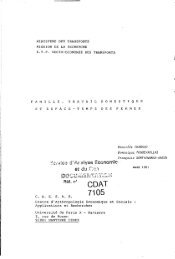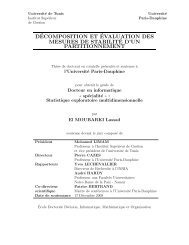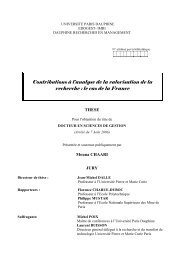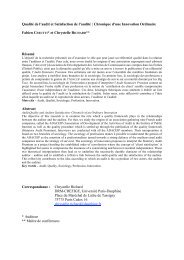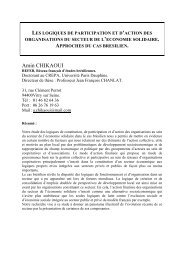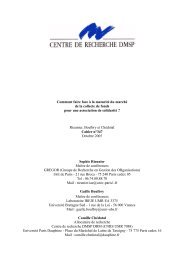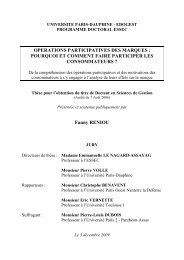12-02-Cahier-R- ... e-Chevallier-Gastineau.pdf - Base ...
12-02-Cahier-R- ... e-Chevallier-Gastineau.pdf - Base ...
12-02-Cahier-R- ... e-Chevallier-Gastineau.pdf - Base ...
Create successful ePaper yourself
Turn your PDF publications into a flip-book with our unique Google optimized e-Paper software.
egins by summarizing air traffic and corresponding jet fuel demand forecasts obtained by<br />
Chèze et al. (2010, 2011). Their results mostly depend on two broad hypotheses. The first<br />
one concerns the future evolution of economic activity in the various regions (estimated from<br />
regional GDP growth indicators). The second hypothesis deals with the energy efficiency<br />
coefficients that have been chosen to conduct the analysis, as well as their evolution overtime<br />
(i.e. energy efficiency gains). Thus, we present the CO2 emissions projections obtained in our<br />
benchmark scenario, and then we evaluate the robustness of these results obtained depending<br />
on these two broad hypotheses.<br />
This modeling, and the associated forecasts, are applied to eight geographical zones and<br />
at the world level (i.e. the sum of the eight regions) by specifying a dynamic model on panel<br />
data. Air traffic forecasts are computed for the following regions: Central and North America,<br />
Latin America, Europe, Russia and Commonwealth of Independent States (CIS), Africa, the<br />
Middle East, Asian countries and Oceania (except China). The eighth region is China, in<br />
order to have a specific focus on this country. By doing so, this article proposes an analysis of<br />
potential future trends of air transport CO2 emissions, both at the world and regional levels,<br />
as a simple analysis of the future yearly mean growth rates of world air traffic emissions may<br />
mask a wide heterogeneity between geographical zones.<br />
2.1 Forecasting air traffic until 2<strong>02</strong>5 . . .<br />
Air traffic projections are estimated by using econometric methods based on the historical<br />
relationship between air traffic and its main drivers (Chèze et al., 2010). Air traffic projec-<br />
tions proposed are obtained by using ICAO’s air traffic data 13 during 1980-2007. According<br />
to the literature 14 , the air traffic drivers are mainly (i) GDP growth rates, (ii) ticket prices,<br />
(iii) alternative transport modes (such as train) and (iv) some external shocks such as the<br />
September 11 th terrorist attacks in 2001. Last but not least, the magnitude of these drivers<br />
appears to depend on the maturity of the transport market: the growth rates of the domestic<br />
markets of industrialized countries are lower than those of emerging countries for instance,<br />
ceteris paribus. To take into account the latter criteria, the econometric modeling proposed<br />
13 The “Commercial Air Carriers - Traffic” database of the ICAO provides air traffic for both cargo and<br />
passenger traffic. These data are both expressed in Revenue Tonne-Kilometre (RTK), so that they can be<br />
re-aggregated together. A Revenue Tonne-Kilometre denotes one tonne of load (passengers and/or cargo)<br />
transported one kilometre.<br />
14 See in particular DfT (2009), ECI (2006), Eyers et al. (2004), Gately (1988), IPCC (1999), Macintosh and<br />
Wallace (2009), Mayor and Tol (2010), RCEP (20<strong>02</strong>), Vedantham and Oppenheimer (1994, 1998), Wickrama<br />
et al. (2003).<br />
8



